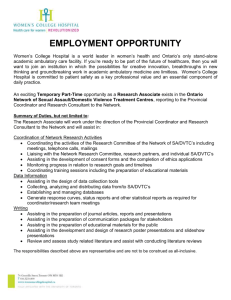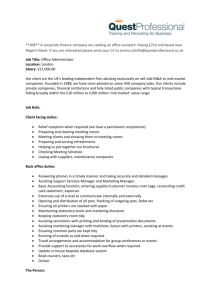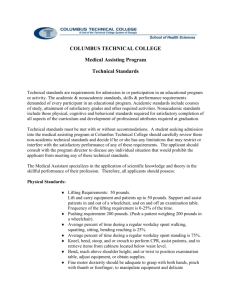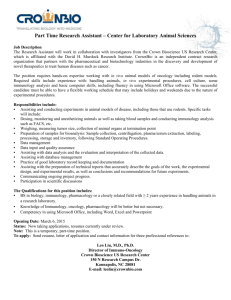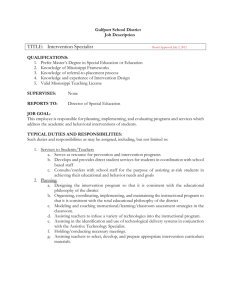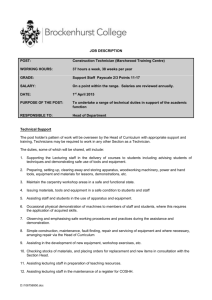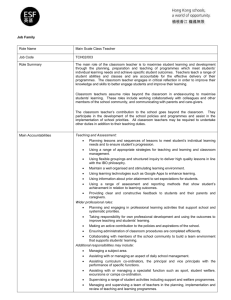Non-Medical In-Home Caregiver
advertisement
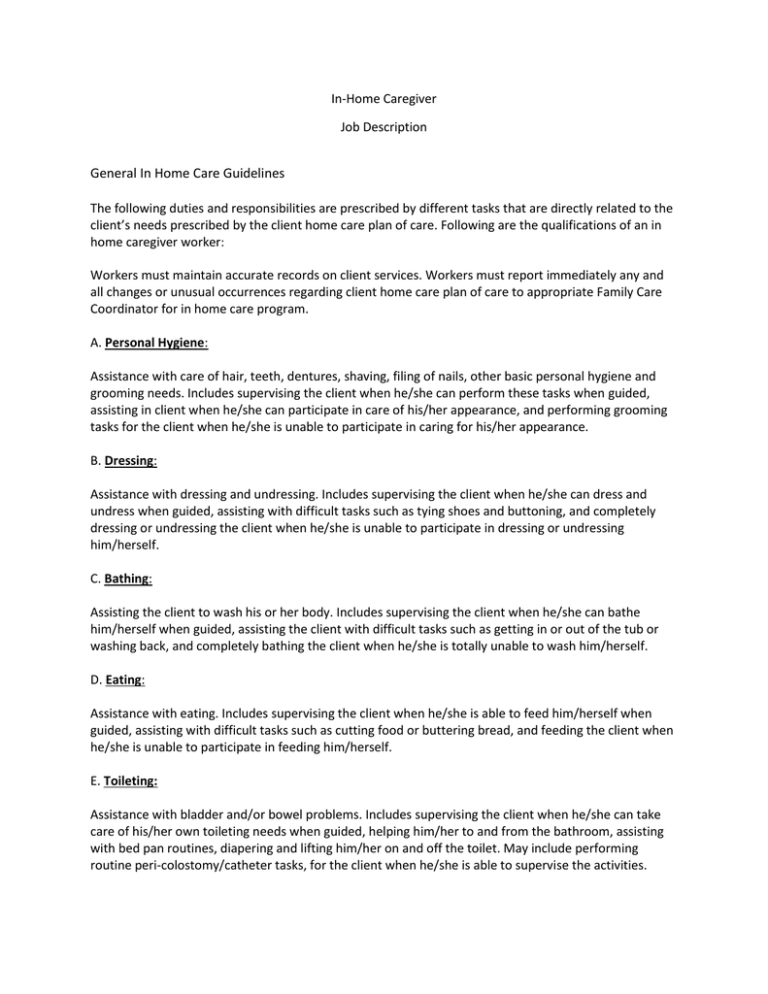
In-Home Caregiver Job Description General In Home Care Guidelines The following duties and responsibilities are prescribed by different tasks that are directly related to the client’s needs prescribed by the client home care plan of care. Following are the qualifications of an in home caregiver worker: Workers must maintain accurate records on client services. Workers must report immediately any and all changes or unusual occurrences regarding client home care plan of care to appropriate Family Care Coordinator for in home care program. A. Personal Hygiene: Assistance with care of hair, teeth, dentures, shaving, filing of nails, other basic personal hygiene and grooming needs. Includes supervising the client when he/she can perform these tasks when guided, assisting in client when he/she can participate in care of his/her appearance, and performing grooming tasks for the client when he/she is unable to participate in caring for his/her appearance. B. Dressing: Assistance with dressing and undressing. Includes supervising the client when he/she can dress and undress when guided, assisting with difficult tasks such as tying shoes and buttoning, and completely dressing or undressing the client when he/she is unable to participate in dressing or undressing him/herself. C. Bathing: Assisting the client to wash his or her body. Includes supervising the client when he/she can bathe him/herself when guided, assisting the client with difficult tasks such as getting in or out of the tub or washing back, and completely bathing the client when he/she is totally unable to wash him/herself. D. Eating: Assistance with eating. Includes supervising the client when he/she is able to feed him/herself when guided, assisting with difficult tasks such as cutting food or buttering bread, and feeding the client when he/she is unable to participate in feeding him/herself. E. Toileting: Assistance with bladder and/or bowel problems. Includes supervising the client when he/she can take care of his/her own toileting needs when guided, helping him/her to and from the bathroom, assisting with bed pan routines, diapering and lifting him/her on and off the toilet. May include performing routine peri-colostomy/catheter tasks, for the client when he/she is able to supervise the activities. F. Ambulation: Assisting the client to move around. Includes supervising the client when he/she can talk alone or with the help of a mechanical device (such as a walker) when guided, assisting with difficult parts of walking (such as climbing stairs), supervising the client when he/she is able to propel his/her wheelchair when guided, pushing the wheelchair, and providing constant physical assistance to the client when he/she is totally unable to walk alone or with a mechanical device. G. Transfer: Assistance with getting in and out of bed or wheelchair or on and off the toilet and/or in and out of the bath tub. Includes supervising the client when he/she is able to transfer when guided, provided steadying, and helping the client when he/she can assist in his/her transfer. *Lifting the client when he/she is unable to assist in their transfer requires specialized training. H. Positioning: Assisting the client to assume a desired position. Includes assistance in turning and positioning to prevent secondary disabilities, such as contracture and balance deficits. I. Self-Medication: Assisting the client to self-administer medications prescribed by his or her physician. Includes reminding the client of when it is time to take prescribed medication, handing the medication container to the client and opening a container. J. Body Care: Assisting the client with exercises, skin care (including the application of ointments or lotions), changing dry bandages or dressings which do not require professional judgment. Excludes foot care beyond washing of feet and filing toenails. Excludes changing bandages or dressings when sterile procedures are required. Provision of body care tasks is limited; the client must be able to supervise the provision of these tasks. K. Travel to Medical Services: Accompanying or transporting the client to a physician’s office or clinic in the local area to obtain medical diagnosis or treatment. L. Essential Shopping: Assistance with shopping to meet the client’s health care or nutritional needs. Limited to brief, occasional trips in the local area to shop for food, medical necessities and household items required specifically for the health and maintenance of the client. Includes assisting the client when he/she can participate in shopping and doing the shopping for the client when he/she is able to participate. M. Meal Preparation: Assistance with preparing meals. Includes planning meals (including special diets), assisting clients who are able to participate in meal preparation, preparing meals for participants unable to participate, and cleaning up after meals. N. Household Assistance: Assistance with household tasks essential to the client’s health and comfort. These tasks are limited to such things as changing bed linens, laundering bed linens and clothing used by the client and cleaning areas of the home occupied by the client. Includes assisting clients who can participate in performing these tasks and performing household tasks for clients unable to participate. O. Standby Assistance: a. Being available to help the client with tasks that cannot be scheduled (toileting, ambulation, transfer, positioning, some medication assistance); and/or b. Being available to provide protective supervision to a client who cannot be left alone because of confusion, forgetfulness, or lack of judgment. Additional Job Skills and Requirements: Attention to Detail: Some clients have specific rules or schedules that must be minded, or specific rules that must be followed. Interpersonal Skills: Caregivers work in a very personal way with their clients. Some will be in pain or very sensitive to their fragility. Caregivers must be sensitive and compassionate with clients. Stamina: Caregivers might need to lift clients into the bathtub, cars and into bed, and need strength. Time Management: Caregivers are schedule keepers. Caregivers have to be there to make sure clients get up on time, make sure medication is taken on schedule and clients get to appointments on time. Typical Work Schedule: Based completely on the clients care plan. May be scheduled to work during the day, during the evening, and/or overnight. This includes weekends and holidays. Typical Compensation: Above average hourly rate commensurate with qualifications and experience.
